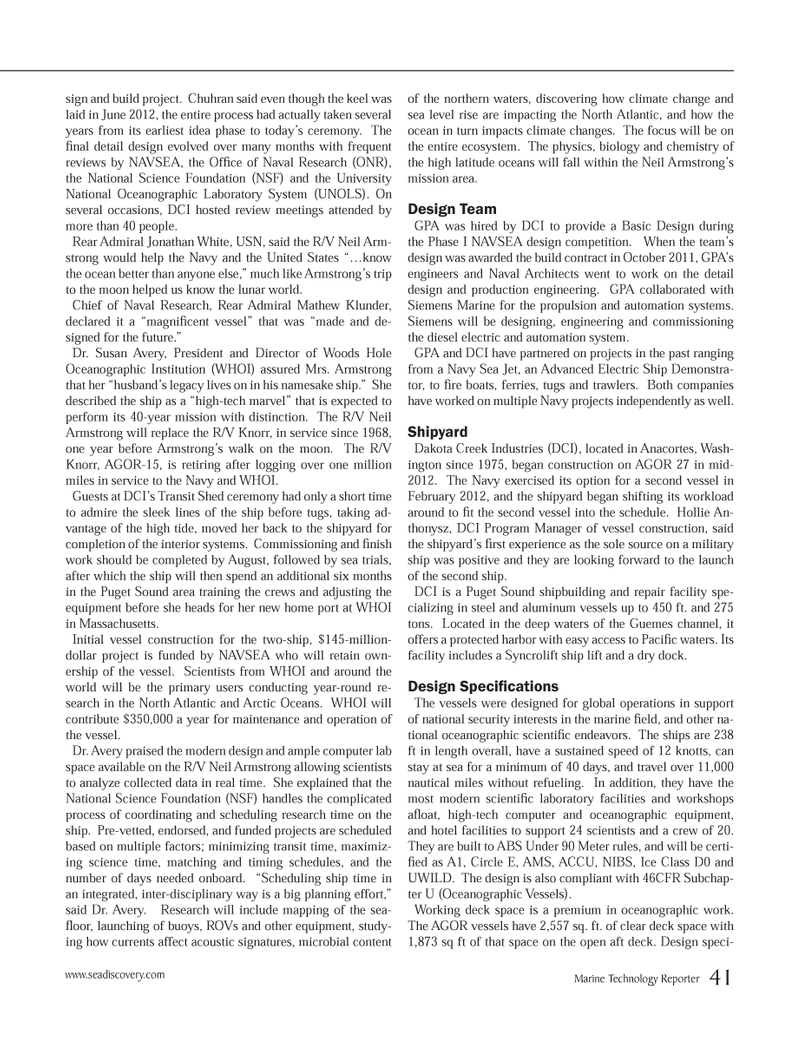
Page 41: of Marine Technology Magazine (May 2014)
AUV Operations
Read this page in Pdf, Flash or Html5 edition of May 2014 Marine Technology Magazine
sign and build project. Chuhran said even though the keel was laid in June 2012, the entire process had actually taken several years from its earliest idea phase to today?s ceremony. The nal detail design evolved over many months with frequent reviews by NAVSEA, the Of ce of Naval Research (ONR), the National Science Foundation (NSF) and the University National Oceanographic Laboratory System (UNOLS). On several occasions, DCI hosted review meetings attended by more than 40 people.Rear Admiral Jonathan White, USN, said the R/V Neil Arm- strong would help the Navy and the United States ??know the ocean better than anyone else,? much like Armstrong?s trip to the moon helped us know the lunar world. Chief of Naval Research, Rear Admiral Mathew Klunder, declared it a ?magni cent vessel? that was ?made and de- signed for the future.? Dr. Susan Avery, President and Director of Woods Hole Oceanographic Institution (WHOI) assured Mrs. Armstrong that her ?husband?s legacy lives on in his namesake ship.? She described the ship as a ?high-tech marvel? that is expected to perform its 40-year mission with distinction. The R/V Neil Armstrong will replace the R/V Knorr, in service since 1968, one year before Armstrong?s walk on the moon. The R/V Knorr, AGOR-15, is retiring after logging over one million miles in service to the Navy and WHOI. Guests at DCI?s Transit Shed ceremony had only a short time to admire the sleek lines of the ship before tugs, taking ad-vantage of the high tide, moved her back to the shipyard for completion of the interior systems. Commissioning and nish work should be completed by August, followed by sea trials, after which the ship will then spend an additional six months in the Puget Sound area training the crews and adjusting the equipment before she heads for her new home port at WHOI in Massachusetts. Initial vessel construction for the two-ship, $145-million- dollar project is funded by NAVSEA who will retain own- ership of the vessel. Scientists from WHOI and around the world will be the primary users conducting year-round re- search in the North Atlantic and Arctic Oceans. WHOI will contribute $350,000 a year for maintenance and operation of the vessel. Dr. Avery praised the modern design and ample computer lab space available on the R/V Neil Armstrong allowing scientists to analyze collected data in real time. She explained that the National Science Foundation (NSF) handles the complicated process of coordinating and scheduling research time on the ship. Pre-vetted, endorsed, and funded projects are scheduled based on multiple factors; minimizing transit time, maximiz- ing science time, matching and timing schedules, and the number of days needed onboard. ?Scheduling ship time in an integrated, inter-disciplinary way is a big planning effort,? said Dr. Avery. Research will include mapping of the sea- oor, launching of buoys, ROVs and other equipment, study- ing how currents affect acoustic signatures, microbial content of the northern waters, discovering how climate change and sea level rise are impacting the North Atlantic, and how the ocean in turn impacts climate changes. The focus will be on the entire ecosystem. The physics, biology and chemistry of the high latitude oceans will fall within the Neil Armstrong?s mission area.Design Team GPA was hired by DCI to provide a Basic Design during the Phase I NAVSEA design competition. When the team?s design was awarded the build contract in October 2011, GPA?s engineers and Naval Architects went to work on the detail design and production engineering. GPA collaborated with Siemens Marine for the propulsion and automation systems. Siemens will be designing, engineering and commissioning the diesel electric and automation system. GPA and DCI have partnered on projects in the past ranging from a Navy Sea Jet, an Advanced Electric Ship Demonstra- tor, to re boats, ferries, tugs and trawlers. Both companies have worked on multiple Navy projects independently as well. Shipyard Dakota Creek Industries (DCI), located in Anacortes, Wash- ington since 1975, began construction on AGOR 27 in mid- 2012. The Navy exercised its option for a second vessel in February 2012, and the shipyard began shifting its workload around to t the second vessel into the schedule. Hollie An- thonysz, DCI Program Manager of vessel construction, said the shipyard?s rst experience as the sole source on a military ship was positive and they are looking forward to the launch of the second ship. DCI is a Puget Sound shipbuilding and repair facility spe- cializing in steel and aluminum vessels up to 450 ft. and 275 tons. Located in the deep waters of the Guemes channel, it offers a protected harbor with easy access to Paci c waters. Its facility includes a Syncrolift ship lift and a dry dock. Design SpeciÞ cationsThe vessels were designed for global operations in support of national security interests in the marine eld, and other na- tional oceanographic scienti c endeavors. The ships are 238 ft in length overall, have a sustained speed of 12 knotts, can stay at sea for a minimum of 40 days, and travel over 11,000 nautical miles without refueling. In addition, they have the most modern scienti c laboratory facilities and workshops a oat, high-tech computer and oceanographic equipment, and hotel facilities to support 24 scientists and a crew of 20. They are built to ABS Under 90 Meter rules, and will be certi- ed as A1, Circle E, AMS, ACCU, NIBS, Ice Class D0 and UWILD. The design is also compliant with 46CFR Subchap- ter U (Oceanographic Vessels). Working deck space is a premium in oceanographic work. The AGOR vessels have 2,557 sq. ft. of clear deck space with 1,873 sq ft of that space on the open aft deck. Design speci-www.seadiscovery.com Marine Technology Reporter 41MTR #4 (34-49).indd 41MTR #4 (34-49).indd 415/12/2014 4:18:53 PM5/12/2014 4:18:53 PM

 40
40

 42
42
